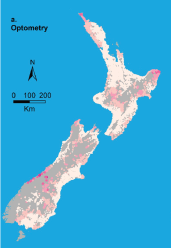
Key messages:
Travel distance is unlikely to be a barrier to accessing eye health services for most New Zealanders. However, there are communities in the most deprived areas that also have long distances to travel to eye clinics. These communities are often in areas with relatively more Māori. Making eye health services more accessible for these communities should be prioritised if we are to improve eye health in New Zealand equitably.
Read the published research paper and download a plain language summary of the findings.
Why did we do this research?
Some New Zealanders face many barriers to good eye health. One of these barriers could be the distance they must travel to reach services. To make eye health services more accessible, we need to understand which communities have furthest to travel, especially when those communities may already be under resourced.
In 2022, Community Eye Health researchers published their research reporting how far New Zealanders need to travel to reach their closest eye care provider. The research showed that people living in the most deprived areas of New Zealand sometimes have the longest distances to travel to eye clinics. To achieve equity in eye care, we need to make these services more accessible.
What was the aim of this research?
The aim of this research was to find out how far people need to travel to eye clinics (optometrists and ophthalmologists) across Aotearoa New Zealand. The researchers also identified communities in the most deprived areas that were more than 50 kilometres from eye clinics, because these communities might benefit from closer services.
What did we do?
To understand how far people travel for eye health services, our researchers used data held by Stats NZ Tatauranga Aotearoa to count and locate all New Zealanders. They then used the addresses of all optometry and ophthalmology clinics in Aotearoa to calculate the travel distance—along our road network—between each clinic and the population. They also calculated the proportion of New Zealanders living more than 50 kilometres from clinics, and looked at distances for people living in different districts and levels of area deprivation.
What are the main results?
The researchers found 344 optometry, 46 public ophthalmology and 90 private ophthalmology clinics. Three-quarters of New Zealanders lived within 10 km of an optometry clinic and half lived within 10 km of an ophthalmology clinic. Nationally, approximately 1 in 35 people lived further than 50km from an optometry clinic compared to 1 in 14 and 1 in 10 living further than 50km from public and private ophthalmology. The researchers identified communities with high area-level deprivation that were more than 50km from eye health services. These communities were predominantly in Tairāwhiti and Northland, but there were also some in Whanganui, Hawke’s Bay, Bay of Plenty and Waikato.
Citation: Ramke J, Zhao J, Wilson O, et al. Geographic access to eye health services in Aotearoa New Zealand: which communities are being left behind? Clin Exp Optom. 2023;106:158–64. doi: 10.1080/08164622.2022.2102410
Funding: Blind Low Vision New Zealand.
